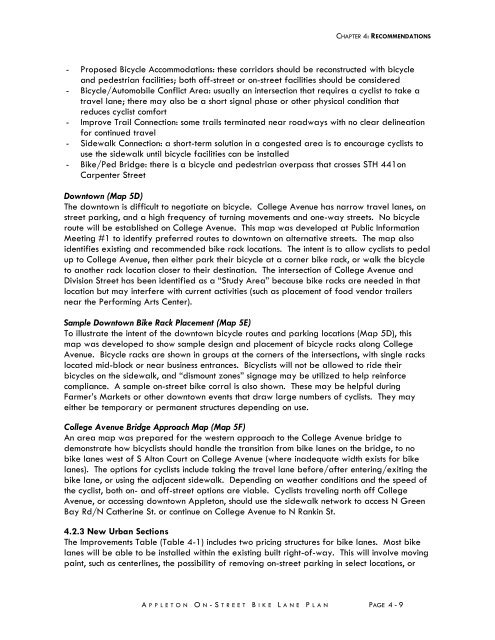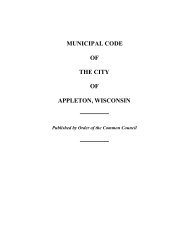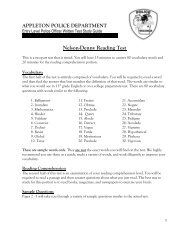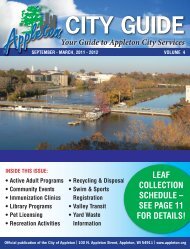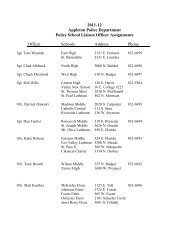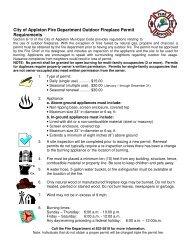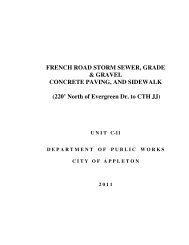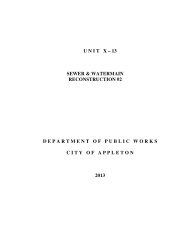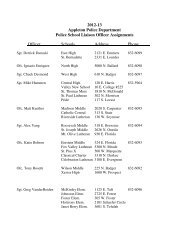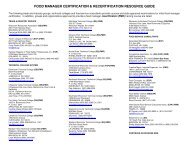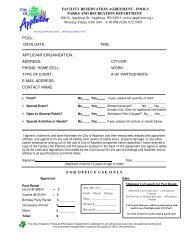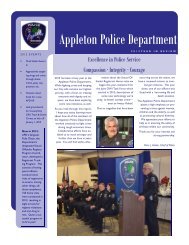City of Appleton On-Street Bike Lane Plan
City of Appleton On-Street Bike Lane Plan
City of Appleton On-Street Bike Lane Plan
You also want an ePaper? Increase the reach of your titles
YUMPU automatically turns print PDFs into web optimized ePapers that Google loves.
CHAPTER 4: RECOMMENDATIONS<br />
- Proposed Bicycle Accommodations: these corridors should be reconstructed with bicycle<br />
and pedestrian facilities; both <strong>of</strong>f-street or on-street facilities should be considered<br />
- Bicycle/Automobile Conflict Area: usually an intersection that requires a cyclist to take a<br />
travel lane; there may also be a short signal phase or other physical condition that<br />
reduces cyclist comfort<br />
- Improve Trail Connection: some trails terminated near roadways with no clear delineation<br />
for continued travel<br />
- Sidewalk Connection: a short-term solution in a congested area is to encourage cyclists to<br />
use the sidewalk until bicycle facilities can be installed<br />
- <strong>Bike</strong>/Ped Bridge: there is a bicycle and pedestrian overpass that crosses STH 441on<br />
Carpenter <strong>Street</strong><br />
Downtown (Map 5D)<br />
The downtown is difficult to negotiate on bicycle. College Avenue has narrow travel lanes, on<br />
street parking, and a high frequency <strong>of</strong> turning movements and one-way streets. No bicycle<br />
route will be established on College Avenue. This map was developed at Public Information<br />
Meeting #1 to identify preferred routes to downtown on alternative streets. The map also<br />
identifies existing and recommended bike rack locations. The intent is to allow cyclists to pedal<br />
up to College Avenue, then either park their bicycle at a corner bike rack, or walk the bicycle<br />
to another rack location closer to their destination. The intersection <strong>of</strong> College Avenue and<br />
Division <strong>Street</strong> has been identified as a “Study Area” because bike racks are needed in that<br />
location but may interfere with current activities (such as placement <strong>of</strong> food vendor trailers<br />
near the Performing Arts Center).<br />
Sample Downtown <strong>Bike</strong> Rack Placement (Map 5E)<br />
To illustrate the intent <strong>of</strong> the downtown bicycle routes and parking locations (Map 5D), this<br />
map was developed to show sample design and placement <strong>of</strong> bicycle racks along College<br />
Avenue. Bicycle racks are shown in groups at the corners <strong>of</strong> the intersections, with single racks<br />
located mid-block or near business entrances. Bicyclists will not be allowed to ride their<br />
bicycles on the sidewalk, and “dismount zones” signage may be utilized to help reinforce<br />
compliance. A sample on-street bike corral is also shown. These may be helpful during<br />
Farmer’s Markets or other downtown events that draw large numbers <strong>of</strong> cyclists. They may<br />
either be temporary or permanent structures depending on use.<br />
College Avenue Bridge Approach Map (Map 5F)<br />
An area map was prepared for the western approach to the College Avenue bridge to<br />
demonstrate how bicyclists should handle the transition from bike lanes on the bridge, to no<br />
bike lanes west <strong>of</strong> S Alton Court on College Avenue (where inadequate width exists for bike<br />
lanes). The options for cyclists include taking the travel lane before/after entering/exiting the<br />
bike lane, or using the adjacent sidewalk. Depending on weather conditions and the speed <strong>of</strong><br />
the cyclist, both on- and <strong>of</strong>f-street options are viable. Cyclists traveling north <strong>of</strong>f College<br />
Avenue, or accessing downtown <strong>Appleton</strong>, should use the sidewalk network to access N Green<br />
Bay Rd/N Catherine St. or continue on College Avenue to N Rankin St.<br />
4.2.3 New Urban Sections<br />
The Improvements Table (Table 4-1) includes two pricing structures for bike lanes. Most bike<br />
lanes will be able to be installed within the existing built right-<strong>of</strong>-way. This will involve moving<br />
paint, such as centerlines, the possibility <strong>of</strong> removing on-street parking in select locations, or<br />
A PPLETON O N -STREET B IKE L ANE P LAN<br />
PAGE 4 - 9


